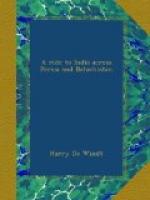The population of Koom, which now amounts to little more than between ten and twelve thousand, was formerly much larger. Like many other Persian cities—saving, perhaps, Teheran—it retains but little of its greatness, either as regards art or commerce. The bazaar is, notwithstanding, extensive and well supplied. Koom is noted for the manufacture of a white porous earthenware, which is made into flasks and bottles, some of beautiful design and workmanship.
The city is entered from the north by a substantial stone bridge, spanning a swift but shallow river. It presents, at first sight, much more the appearance of a Spanish or Moorish town than a Persian one. The dirty brown mud huts are replaced by picturesque white houses, with coloured domes, gaily striped awnings, and carved wooden balconies overhanging the stream. Riding through the city gate, we plunge from dazzling sunshine into the cool semi-darkness of the bazaar, through which we ride for at least a quarter of an hour, when a sudden turning brings us once more into daylight in the yard of a huge caravanserai, crowded with mule and camel caravans.
The apartment or cell allotted to us was, however, so filthy that we decided to push on at once to Pasingan, the next stage, four farsakhs distant. Koom is noted for the size and venom of its scorpions; and the dim recesses of the dark, cobwebby chamber, with its greasy walls and smoke-blackened ceiling, looked just the place for these undesirable bedfellows.
So we rode on again into the open country, past crowds of beggars and dervishes at the eastern gate, as usual, busily engaged, as soon as they saw us coming, at their devotions. Clear of the city walls, one sees nothing on every side but huge storks. They are held sacred by the natives, being supposed to migrate to Mecca every year. I heard at Ispahan that, notwithstanding the outward austerity and piety of the people of Koom, there is no town in Persia where so much secret depravity and licentiousness are carried on as in the “Holy City.”
The stage from Koom to Pasingan was accomplished in an incredibly short time; and I may here mention that this was the only occasion upon which, in Persia, I was ever given a fairly good horse. The word chapar signifies in Persian to “gallop,” but it is extremely rare to find “chapar post” pony which has any notion of going out of his own pace—something between a walk and a canter, like the old grey horse that carries round the lady in pink and spangles in a travelling circus. But to-day I got hold of a wiry, game little chestnut, who was evidently new to the job, and reached and tore away at his bridle as if he enjoyed the fun. Seeing, about half-way, that he was bleeding at the mouth, I called Gerome’s attention to the fact, and found that his horse was in the same plight—as, indeed, was every animal we passed on the road between Koom and Pasingan. This is on account of the water at and between the two places, which is full of small leeches, invisible except through a microscope. Horses, mules, and cattle suffer much in consequence, for nothing can be done to remedy the evil.




